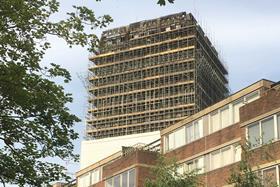Using non-combustible cladding material could add more than £60/m2 to high-rise buildings

The government’s estimate that a proposed ban on combustible cladding would add up to an extra £75,000 to a building’s cost is already being challenged as too low by the industry.
On Monday, housing secretary James Brokenshire launched a consultation on the use of combustibles on the external walls of high-rise residential buildings that are 18m high or over.
It closes on 14 August, and Brokenshire told MPs: “I have listened carefully to concerns and I intend to ban the use of combustible materials on the external walls of high-rise residential buildings, subject to consultation.”
The consultation document estimated the additional costs of using non-combustible cladding materials ranged from £15 to £44/m2.
The figures are for the surface area of cladding and, according to the consultation, this could add up to an extra £75,000 for a 15-storey building.
But speaking at an event on fire safety last week, Arcadis’ head of strategic research, Simon Rawlinson, said the ban would add an extra 25% to the government’s highest estimate, coming in at an extra £60/m2 in construction costs.
Rawlinson warned the costs could go even higher than £60/m2, saying: “The costs I presented were for the cladding only and we would need to allow for insulation as well.”
And he said adding a second escape stair to high-rise residential buildings, as called for by the RIBA, could mean some developments would not be viable.
Fitting an additional stair on developments in outer London would make those with one-third affordable housing less attractive to banks, with returns falling to 18%.
Rawlinson questioned whether finance houses would lend on developments with less than 20% return, meaning developments with higher percentages of affordable housing would not be viable. He also said the impact would be greater outside London, where sales values are lower.
The government’s proposals include making changes to legislation in its consultation to amend the building regulations dealing with fire safety, meaning failure to comply with the new rules would lead to prosecution in a magistrates’ court, that would have the power to impose an unlimited fine.
Under the proposals, materials would need to have a combustibility rating of A2 or better under the European Classification EN 13501, which classifies the combustibility of construction products from Class A to Class E. References to the equivalent British Standard would be removed from ��ɫ����TV Regulations.
The government said the principal benefit of an outright ban was that it would “make routes to compliance clearer, which reduces the risk of unintentional non-compliance”.
This week's poll: Do you agree with the government's proposal to ban combustible materials in cladding systems?
— ��ɫ����TV ��ɫ����TV (@��ɫ����TV��ɫ����TV)



























No comments yet